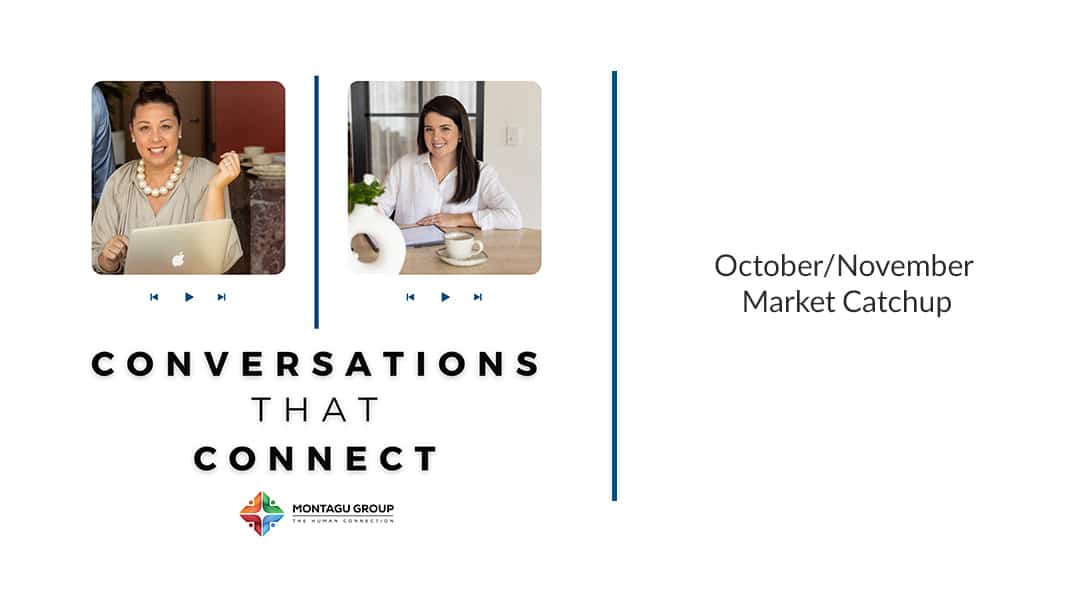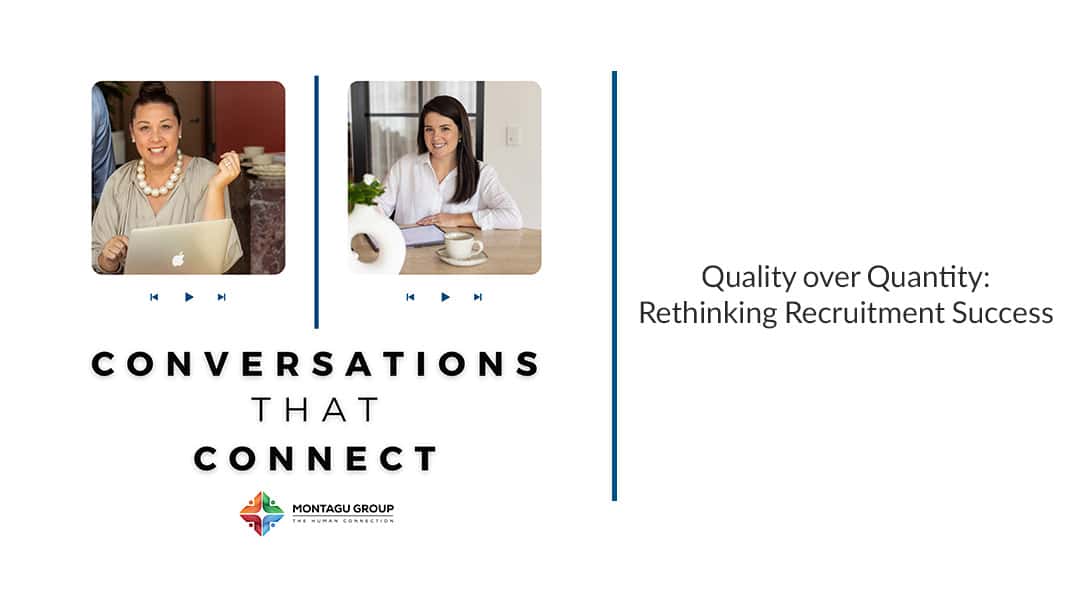
October/November Market Catch Up
Suki and Tayla explore the current wave of corporate redundancies, particularly focusing on the impact of international corporations buying out Australian companies. It highlights the resulting job market challenges, including funding issues and the struggle for individuals to find work despite available opportunities
October/November Market Catch-Up
As we close out October and step into November, the energy across the job market feels… off. It’s not panic, not quite stagnation — just a strange in-between where uncertainty and apathy seem to hang in the air.
If you’ve been feeling like things are shifting under your feet — you’re not alone. Across industries, from IT to digital to corporate sectors, both employers and jobseekers are trying to make sense of a market that’s behaving in ways we haven’t quite seen before.
At Montagu Group, we’ve spent the last few months deep in conversation with candidates, clients, and other recruiters — and there’s a clear theme emerging: the market is weird right now.
So, let’s unpack what’s going on, what we’re seeing from both sides, and where things might be heading as we edge closer to the end of the year.
A Market Unlike Any Other
It’s not just one thing — it’s everything.
The past few months have seen another wave of redundancies hit Australian companies, many of which are tied to global buyouts and restructures. Large U.S. corporations are acquiring local businesses and, in turn, trimming teams or dissolving entire divisions.
In recruitment, we’re hearing stories daily of roles being paused, contracts pulled, or funding suddenly drying up on projects that were meant to run for years.
And while there’s still plenty of work available on paper, the sentiment in the market feels cautious — even hesitant. As one of our senior candidates put it, “Something’s happening, but I can’t quite put my finger on it.”
That’s the best way to describe it: apathy. Not from a lack of motivation, but from an industry trying to recalibrate after years of turbulence.
Unemployment Is Rising — But the Story’s More Complex
The numbers paint part of the picture.
In August, Australia’s unemployment rate was 4.3% — by September, it had risen to 4.5%.
At first glance, that might not seem huge, but within a single month, that shift reflects thousands of people entering unemployment. And from what we’re hearing, October hasn’t brought much relief.
But here’s the nuance: while there are more candidates in the market, that doesn’t mean it’s suddenly an employer’s market again.
Sure, we’re being flooded with applications — some roles are seeing upwards of 80 to 90 applicants — but that doesn’t mean those candidates are the right fit. In fact, more often than not, the majority of those applications are mismatched.
So while businesses may feel confident to “go it alone” because they assume there’s plenty of talent out there, what we’re actually seeing is a disconnect between volume and quality.
The Myth of the Employer’s Market
There’s been a lot of talk about the market swinging back to favour employers — but from our experience, that’s not entirely accurate.
Yes, there’s an influx of jobseekers right now. But the best candidates? They’re still working.
They’re either secure in strong roles or — if between jobs — they’re not in a rush. They can afford to be selective, to take a break, to spend time with family, or to wait for the right opportunity rather than the first one that comes along.
We recently spoke to a senior digital manager who summed it up perfectly:
“I’m not actively looking. I’m just taking some time off with my kids. If something great comes up, I’ll take a look — but I’m not applying for the sake of it.”
This kind of mindset is becoming more common, particularly among experienced professionals who’ve built a buffer and can afford to be patient.
So while the market might appear saturated, it’s not necessarily full of the right people — which means companies still need to headhunt, network, and engage strategically to secure top talent.
In short: it’s not an employer’s market; it’s a confusing one.
Recruiters Are Feeling the Pinch Too
It’s not just candidates and clients feeling the squeeze — recruiters are too.
We’ve noticed a growing trend of agency recruiters moving into internal roles, often as a sign of the broader market cooling off. When experienced consultants pivot to corporate positions, it’s usually because the external recruitment landscape has tightened.
That movement tells us that the slowdown is real — not catastrophic, but enough to create a ripple effect across the industry.
And that’s the thing: this isn’t just an IT or digital problem. We’re hearing the same stories from finance, healthcare, education, and beyond. It’s cross-industry, cross-discipline, and global.
Recruitment is cyclical, but this feels different. There’s momentum one week, silence the next, and a general sense that everyone’s holding their breath — waiting for clarity that hasn’t quite arrived.
Seasonal Slowdown — But Earlier Than Usual
Traditionally, things start to quiet down around Melbourne Cup week. Not because of the race itself, but because it marks the unofficial start of that “pre-Christmas slowdown”.
Usually, November is when clients start pausing hiring plans, teams shift focus to end-of-year targets, and candidates hold off on making big career moves until January.
But this year, that pattern started a month early. By early October, we were already feeling the lull that normally comes in late November.
So, does that mean January 2026 will be especially busy? Maybe — but that depends on how long this period of uncertainty lasts.
One thing’s for sure: the usual rhythm of the market has been disrupted, and everyone — from HR to hiring managers to jobseekers — is trying to find their new footing.
What Clients Need to Know Right Now
If you’re an employer or hiring manager, here’s the honest truth:
-
Yes, there are more candidates available, but not necessarily more good ones.
-
Relying solely on inbound applications may leave you sifting through dozens of unsuitable CVs.
-
Headhunting and networking are still crucial — the best candidates often need to be approached directly.
-
Recruitment agencies are still valuable, even in a “candidate-rich” market. Why? Because we filter, engage, and connect with talent that doesn’t apply through traditional channels.
The best recruitment strategies right now combine both reach and relevance — tapping into the volume that’s out there but still focusing on the human connection that makes hiring successful.
And in markets like this, speed matters. The few great candidates that are available move quickly. If you’re dragging your feet on interviews or decision-making, you’ll lose them.
What Candidates Should Keep in Mind
If you’re job hunting right now, you’re probably feeling the squeeze too. You might be sending out applications without hearing much back, or finding that roles get cancelled or delayed mid-process.
Our advice? Don’t lose hope — and don’t rush into something that doesn’t fit.
Here’s what we’re telling candidates:
-
Stay visible. Update your LinkedIn, keep your network warm, and let recruiters know you’re open to opportunities.
-
Be strategic. Don’t apply for everything — focus on roles that truly align with your experience and goals.
-
Keep learning. Use this downtime to upskill, build certifications, or strengthen your digital presence.
-
Communicate openly. If you’re represented by a recruiter, keep the dialogue honest. We’re your advocates, but we can only help if we understand your priorities.
It’s easy to get discouraged, but remember — markets move in cycles. The same slowdown that’s happening now will eventually make way for a surge in opportunity.
Looking Ahead to 2026
So, where are we headed?
The reality is, no one knows for sure. But if history’s any indication, periods of contraction are often followed by renewal.
As companies finalise budgets, stabilise after redundancies, and reframe their growth plans, we’re expecting a rebound in Q1 2026.
In the meantime, we’ll continue to see smaller, more cautious hiring decisions — roles that are business-critical rather than nice-to-have, with more emphasis on fit, culture, and impact than ever before.
The organisations that continue to invest in people — even during quieter times — will come out ahead when the market shifts again. Those that cut too deeply or pull back entirely may find themselves scrambling to rebuild later.
Final Thoughts
There’s no denying that the past few months have been challenging. Recruitment right now feels like a rollercoaster — one where we’re all strapped in together, riding through the dips, bumps, and unexpected turns.
But amid the uncertainty, there’s also opportunity. For employers, it’s a chance to rethink hiring strategies, nurture internal talent, and partner more strategically with agencies. For candidates, it’s a time to reflect, reset, and prepare for the next upswing.
We might not know exactly what’s coming — but we do know this: the market always finds its balance.
And as always, we’ll be here to navigate it with you.
Show Notes
Episode: “October/November Market Catch-Up” — Conversations That Connect, Montagu Group
Hosts: Suki & Tayla
Summary: A candid chat about the current job market — the strange slowdown, the wave of redundancies, and what both clients and candidates can expect heading into the end of the year.
Key Takeaways
- The Australian job market is experiencing unusual volatility across multiple sectors.
- Redundancies and funding pauses are contributing to a sense of instability.
- Despite higher unemployment, it’s not truly an employer’s market — top candidates remain employed or selective.
- Recruitment remains essential to bridge the gap between quantity and quality in applications.
- The seasonal slowdown has come earlier than usual, but a rebound in early 2026 is possible.
- Both employers and candidates should stay proactive and strategic through this period of uncertainty.
If you have a burning topic you’d like to discuss, don’t hesitate to reach out at hello@montagu.com.au.
Join the conversation Today!
click on the button to see a full list of posts from our Conversations that Connect deep dives!
Stay Up to Date With Our Latest Episodes
enter your email to be notified when we release a new episode of Conversations that Connect.





